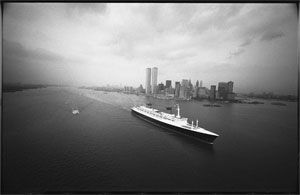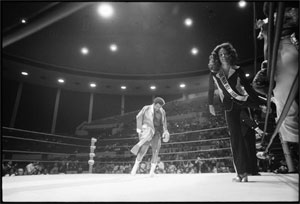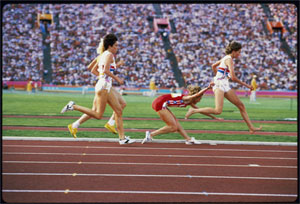 |
→ October 2005 Contents → Feature
|
In Praise of ADD
|
 |
|||||||||||
|
George Carlin once said that he was in favor of Attention Deficit Disorder because there's nothing in this country worth concentrating on anyway. David Burnett would say that there was too much. By his own admission, Burnett was "ADD before ADD was cool." This is not to say that he actually suffers from the condition as far as we know, but rather uses it as a metaphor to describe the remarkably diverse range of subject matter to which he has turned his lens over a 40-year period. Of course, four decades give you plenty of time to point your camera at many things, but David has never been a single-theme photographer, and his curiosity and prolific output have given his photographs a range that few, if any, of his contemporaries can match. The depth and breadth of his achievement was apparent at his recent and enthusiastically received show at Visa Pour l'Image in Perpignan, France, a show that he described as more of an introspective than a retrospective.
It was what led him from the hallowed environment of Salt Lake City to the fleshpots of the Time and Life Building in New York City after his freshman year at Colorado College. Ruth Lester, who was in charge of interviewing photographers at LIFE, saw his work, and, because she had nothing available, sent him to Time magazine, where Charlie Jackson hired him as a summer intern for three days a week, although he admits nobody really knew what his responsibilities were. "The first day I showed up in a suit and tie with a big camera bag with every camera I owned. I could barely lift it." But he found a table that was used to store the day's selection of newspapers, cleared it off and positioned himself there. "The good thing about it was that just on the other side of the wall was Michelle Stephenson, who was the business editor, and next to her was Linda George, who was doing Nation, and when they had something that had to be done on a moment's notice all they had to do was yell, 'David, are you there?' And there I was." It led to him having 11 pictures published in Time that summer and a relationship with the publication that exists to this day.
It was the "Be There" principle that took Burnett to Vietnam in 1970, despite the fact that the draft board had rejected him because of an ice hockey injury that had required spinal fusion. He had been in Miami for Time when they closed the bureau and moved the writer with whom he had been working to Atlanta, leaving him somewhat stranded. "John Olsen, who'd become a good friend of mine and was a young LIFE magazine photographer, had gone to Vietnam in the summer of 1970 and when he came back he said, 'Jeez, you know there's still tons of stories to do there. It's still the big story. You ought to just go.' So I bought a ticket and made ready to go." Making ready to go in this case consisted of not only a considerable financial investment on the part of the photographer but also the procurement of letters that established your credentials for the military authorities, in his case one from Time and one from LIFE. The one from Time came with a bonus from the new and soon-to-be-legendary picture editor John Durniak. It took the form of a $500 guarantee plus a box of Ektachrome to do a story on the children of war. When he asked Durniak what this meant he was told, "Whatever you make it to mean."
Vietnam also taught him another lesson that would be of value throughout his career as a journalist, but particularly in his time covering politics. It was the realization that "every bureaucracy has as its first and most important goal the maintaining of that bureaucracy, and everything that comes afterwards, whether it's the work they're supposed to accomplish, or the people they're supposed to support, is all secondary to the mere being able to make that bureaucracy stay alive." In conjunction with this came a deep sense of skepticism about official statements, whether they come from military or party headquarters. Another thing that he realized during his time in that resilient country was that he did not want to spend the rest of his career as a combat photographer, that there were other stories that he wanted to cover. This didn't mean that his life would be free of sticky situations, such as the coup d'état in Chile and accompanying American troops in the "liberation" of several small countries, but it was the birth of his daughter in 1986 that finally convinced him to stop "putting myself at risk at the hands of kids with AK-47s."
If anyone has been a witness to history it is David, as is proved by the subject matter of just some of the images in "Too Close": the drought-stricken hills of Niger in 1974; Juan Peron's body in his casket in 1974; President Nixon's resignation, also in 1974; Francois Mitterand at Orly airport in 1977; Sadat in front of the pyramids in Giza in 1977; a rally in front of Ayatollah Khomeini during the Iranian revolution in 1979; a meeting of the Mormon elders the same year; Vietnamese boat people in Malaysia in 1979; a remarkably well-mannered protest in Warsaw in 1981; U.S. troops in Grenada in 1983; the unrolling of the red carpet for Ronald Reagan, one of the few truly funny pictures to come out of Moscow in 1988; the Brandenburg Gate just before the fall of the Berlin Wall in 1989; China's Fu Ming Xia executing a perfect dive at the Olympics in Barcelona in 1992; Cuban fishermen heading out to sea in inner tubes in 1994; Bush's first State of the Union address; John Kerry on the campaign trail in Madison, Wisconsin, in 2004. Each of these events Burnett recorded in a way that is uniquely his, often relying upon its oddity for its effectiveness. It's almost as if the photographer is literally saying to us in these images, "You know, there is another way of looking at this." To compel us to see these world events in a different manner he has elicited the help of a variety of camera manufacturers, as if his ADD tendencies extend there also. The overwhelming winner in the "Which Camera Burnett Uses Most" contest is Canon, five different models of which are given credit in the exhibition. But to back these up he has resorted to a Leica M6, Mamiya 645, Holga, Linhof Master Technica, Widelux - and was probably the only photographer in the age of flash cards and SAT phones to cover Kerry with a Speed Graphic. Like I said, oddity is one of his strengths.
At this point where he has taken time out from his career to look back on it, he has only one piece of advice that he feels comfortable giving to young photographers, and that is to never give up your copyright. The only reason that he can produce a retrospective - or introspective - exhibition is that he estimates he has about 96% of all the pictures he ever shot in his possession, and in over 40 years that's a lot of pictures. Of course there are other reasons like talent, intelligence, commitment and hard work. To paraphrase Picasso, when inspiration comes calling you'd better have your camera out. As he pauses for reflection this single-minded generalist says of his life as a photographer, "I just kind of bounce from one kind of story to the next, and it's been a lot of fun. When I got all these pictures together and I looked at them, even now that I've seen them a number of times, I'm still amazed that all of this diverse work was done by one photographer, and then even a little bit more amazed that I was that one photographer."
© Peter Howe
Executive Editor
|
||||||||||||
Back to October 2005 Contents
|
|



